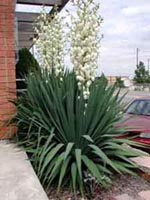Resource Library
Plant of the Week: Spanish Dagger
The University of Arkansas System Division of Agriculture does not promote, support or recommend plants featured in "Plant of the Week." Please consult your local Extension office for plants suitable for your region.
Plant of the Week
Spanish Dagger
Latin: Yucca gloriosa

Plant lovers come in all shapes, sizes and sexes, but as any nurseryman will tell you, the fairer sex makes up the vast majority of their customer base. While most gardeners are women, their rise into the ranks of professional horticulturists and botanists has occurred mostly since the environmental movement of the 1970's. One interesting exception to this was the heiress turned botanist, Susan Delano McKelvey (1883-1964), who spent over a decade studying yuccas, of all things.
About 40 species of yuccas have been described, all of them originating in North America. Yuccas belong to the agave family and are mostly found in the desert southwest from California to Texas. Yucca gloriosa, variously called Palm Lily or Spanish Dagger, is unique because it is an eastern American species and its blooms appear in the fall unlike most species that are spring flowering.
Spanish Dagger Yucca forms short trunks that may reach three feet in length with rosettes of sword-shaped, 24-inch long leaves stacked in whorls up the stems. The leaves are, as with all yuccas, sharp-pointed.
Hundreds of creamy-white flowers are borne on a terminal panicle of blooms that may reach six feet or more in height. The flowers have six petals and are to three inches across and look much like the more common Adam’s needle yucca. The fruit, if they appear, are a three-segmented capsule to three inches long with a distinct restriction about a third of the way down.
McKelvey, of a wealthy Philadelphia family and cousin to future president Franklin Delano Roosevelt, fled a failing marriage in 1919 and moved to Boston where she immersed herself in the study of botany. With the encouragement of Charles Sargent, the longtime director of the Arnold Arboretum, she learned the art of plant collecting in the newly formed Glacier National Park in Montana in the summer of 1921.
McKelvey collected in a grander style than botanists that preceded her. The results of her decade long study of yuccas was the publication of her treaties, Yuccas of the Southwestern United States, which appeared in 1938. But McKelvey is best remembered for her third book, Botanical Explorations of the Trans-Mississippi West 1790-1850, which was published in 1956.
Yuccas are easy to grow in the garden, but they are usually more effective if used in a grouping in the landscape. The drooping characteristic of the older leaves makes the sharp pointed tips of this species less likely to injure than other species. They should have full sun to do their best and the soil should be well drained, especially during the winter months.
When I started my horticultural training in the mid-60's, women made up about 15% of my classes. The environmental movement that hit American culture in the 1970's saw women’s enrollment in horticulture increase to about 45% of the student body. Arkansas’ own Janet Carson was in this first wave of women students into the professional ranks. The percentage of female students in horticulture has remained more or less constant for the past two decades.
By: Gerald Klingaman, retired
Extension Horticulturist - Ornamentals
Extension News - September 27, 2002
The University of Arkansas System Division of Agriculture does not maintain lists of retail outlets where these plants can be purchased. Please check your local nursery or other retail outlets to ask about the availability of these plants for your growing area.